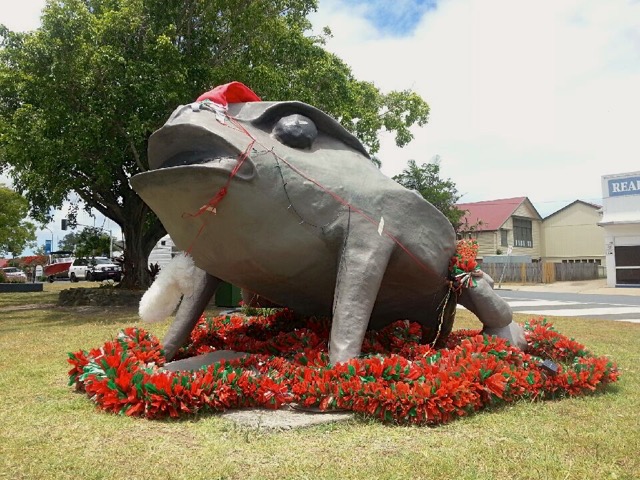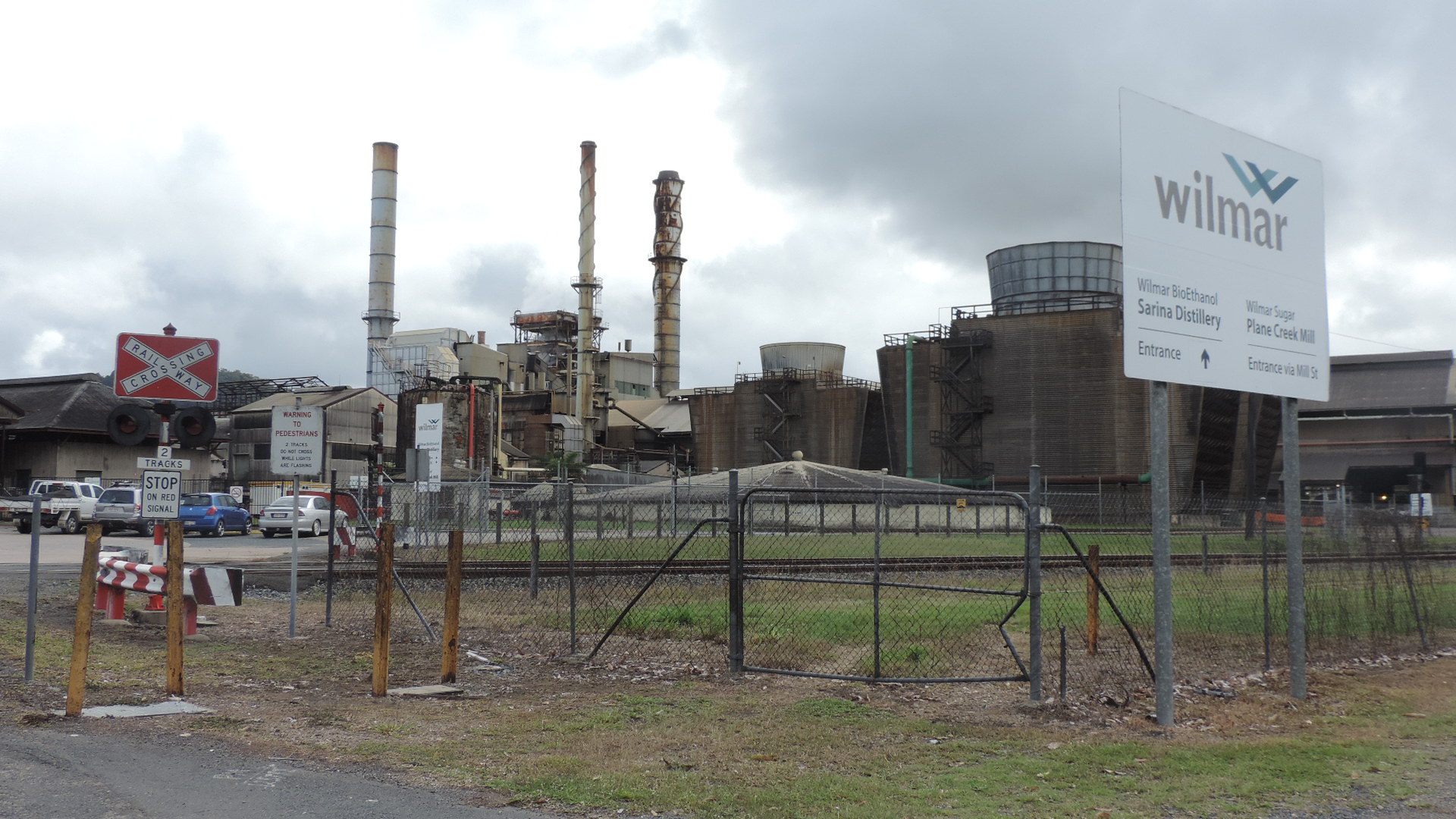|
Sarina War Memorial
Sarina War Memorial is a heritage-listed memorial at Broad Street, Sarina, Mackay Region, Queensland, Australia. It was built in 1919 by Melrose and Fenwick. It was added to the Queensland Heritage Register on 5 December 1997. History The Sarina War Memorial was erected for the ANZAC Day (25 April) ceremonies of 1919 and was produced by Melrose and Fenwick, monumental masons of Townsville. Funds for the memorial were raised by public subscription. The memorial honours the local men of Sarina and the surrounding district who served in the First World War. The memorial was unveiled on 2 October 1920 by Mrs Lucy Ada Heron, mother of Private Leslie Lionel Heron, killed in action on 7 August 1916. The town of Sarina is located south of Mackay and was originally established as a pastoral holding. In the early 1880s, the area was thrown open for selection as sugar cane fields and flourished following the construction of the Plane Creek Sugar Mill in 1896. A supporting infrastru ... [...More Info...] [...Related Items...] OR: [Wikipedia] [Google] [Baidu] |
Sarina, Queensland
Sarina is a rural town and coastal locality in the Mackay Region, Queensland, Australia. In the , Sarina had a population of 5,522 people. Geography Sarina lies just inland of the east coast of Queensland, south of the city of Mackay, and approximately north of the city of Rockhampton. The Bruce Highway passes through the locality from south to north, as does the North Coast railway line. The town of Sarina is located on Plane Creek, which flows into the Coral Sea, but most of the urban development is on the northern side of the creek. The Bruce Highway and the railway line pass through the town, which is served by the Sarina railway station. Plane Creek West (previously known as Plane Creek Upper) is a neighbourhood within the locality (), approximately west of the town of Sarina. The neighbourhood of Oonooie lies 6.8 km south of the town () and is the name of a former railway station on the North Coast line, which was named on 29 April 1915, reportedly after a pr ... [...More Info...] [...Related Items...] OR: [Wikipedia] [Google] [Baidu] |
Plane Creek Sugar Mill
Plane Creek Sugar Mill is a sugar mill in Sarina, Queensland, Australia. It is owned and operated by Wilmar Sugar Australia. History The Plane Creek Sugar Mill opened in 1896. It was owned and operated by the Plane Creek Central Mill Company Limited. It was funded with a loan of £65,000 from the Queensland Government under the Sugar Works Guarantee Act. The mill machinery was built by Walkers Limited in Maryborough. A 15-mile tramline connected the mill to a wharf at the mouth of Louisa Creek () for shipping the sugar. The loan from the Queensland Government was fully repaid in 1920. In 1925, a factory was built next to the mill to process the molasses produced by the sugar refining into ethanol. Ted Theodore, the Queensland Premier, hoped to use the ethanol as a motor fuel. In 1926, a wier was built on Plane Creek to provide a more reliable water supply to the mill, with a second weir built in 1935. In the 1920s, construction of the North Coast railway line enabled ... [...More Info...] [...Related Items...] OR: [Wikipedia] [Google] [Baidu] |
Australian Nationalism
Flag of Australia Australian nationalism asserts that the Australians are a nation and promotes the national and cultural unity of Australia. Australian nationalism has a history dating back to the late 19th century as Australia gradually developed a distinct culture and identity from that of Britain, beginning to view itself as a unique and separate entity and not simply an extension or a derivation of British culture and identity. History Pre-Federation By the early 19th century, Australia was governed as a series of six largely self-governing colonies that were spread across the continent and were part of the British Empire. Attempts to coordinate governance had failed in the 1860s due to a lack of popular support and lack of interest from the British government, but by the 1880s, and with the rise of nationalist movements in Europe, the efforts to establish a federation of the Australian colonies began to gather momentum. The British government supported federation a ... [...More Info...] [...Related Items...] OR: [Wikipedia] [Google] [Baidu] |
Australian Patriotism
Australian patriotism is patriotism involving cultural attachment of Australians to Australia as their homeland. Australian patriotism has been identified by some as distinct from Australian nationalism because of the emphasis of Australian patriotism upon values rather than a commitment to a nation. According to the 2014 World Values Survey, over 90 per cent of Australians are either "very proud" or "quite proud" of their nation. See also * Australianism (other) * Australophile * Australian nationalism * God's Own Country "God's Own Country" is a phrase meaning an area, region or place supposedly favoured by God. Examples Australia In Australia, the phrase "God's own country" was often used to describe the country in the early 1900s, but it appears to have gr ... * Reclaiming Patriotism References {{Australia-stub ... [...More Info...] [...Related Items...] OR: [Wikipedia] [Google] [Baidu] |
Cornice
In architecture, a cornice (from the Italian ''cornice'' meaning "ledge") is generally any horizontal decorative moulding that crowns a building or furniture element—for example, the cornice over a door or window, around the top edge of a pedestal, or along the top of an interior wall. A simple cornice may be formed just with a crown, as in crown moulding atop an interior wall or above kitchen cabinets or a bookcase. A projecting cornice on a building has the function of throwing rainwater free of its walls. In residential building practice, this function is handled by projecting gable ends, roof eaves and gutters. However, house eaves may also be called "cornices" if they are finished with decorative moulding. In this sense, while most cornices are also eaves (overhanging the sides of the building), not all eaves are usually considered cornices. Eaves are primarily functional and not necessarily decorative, while cornices have a decorative aspect. A building's projecti ... [...More Info...] [...Related Items...] OR: [Wikipedia] [Google] [Baidu] |
Cyma Recta Moulding
Moulding (spelled molding in the United States), or coving (in United Kingdom, Australia), is a strip of material with various profiles used to cover transitions between surfaces or for decoration. It is traditionally made from solid Millwork (building material), milled wood or plaster, but may be of plastic or reformed wood. In classical architecture and sculpture, the moulding is often carved in marble or other List of stone, stones. A "plain" moulding has right-angled upper and lower edges. A "sprung" moulding has upper and lower edges that bevel towards its rear, allowing mounting between two non-parallel planes (such as a wall and a ceiling), with an open space behind. Mouldings may be decorated with Patera (architecture), paterae as long, uninterrupted elements may be boring for eyes. Types Decorative mouldings have been made of wood, Rock (geology), stone and cement. Recently mouldings have been made of extruded PVC and Expanded Polystyrene (EPS) as a core with a ceme ... [...More Info...] [...Related Items...] OR: [Wikipedia] [Google] [Baidu] |
Plinth
A pedestal (from French ''piédestal'', Italian ''piedistallo'' 'foot of a stall') or plinth is a support at the bottom of a statue, vase, column, or certain altars. Smaller pedestals, especially if round in shape, may be called socles. In civil engineering, it is also called ''basement''. The minimum height of the plinth is usually kept as 45 cm (for buildings). It transmits loads from superstructure to the substructure and acts as the retaining wall for the filling inside the plinth or raised floor. In sculpting, the terms base, plinth, and pedestal are defined according to their subtle differences. A base is defined as a large mass that supports the sculpture from below. A plinth is defined as a flat and planar support which separates the sculpture from the environment. A pedestal, on the other hand, is defined as a shaft-like form that raises the sculpture and separates it from the base. An elevated pedestal or plinth that bears a statue, and which is raised from ... [...More Info...] [...Related Items...] OR: [Wikipedia] [Google] [Baidu] |
Bollard
A bollard is a sturdy, short, vertical post. The term originally referred to a post on a ship or quay used principally for mooring boats. It now also refers to posts installed to control road traffic and posts designed to prevent automotive vehicles from colliding or crashing into pedestrians and structures, whether intentional from ram-raids and vehicle-ramming attacks, or unintentional losses of control. Etymology The term is probably related to bole, meaning a tree trunk. The earliest citation given by the ''Oxford English Dictionary'' (referring to a maritime bollard) dates from 1844, although a reference in the ''Caledonian Mercury'' in 1817 describes bollards as huge posts. History Wooden posts were used for basic traffic management from at least the beginning of the 18th century. An early well-documented case is that of the "two oak-posts" set up next to the medieval Eleanor cross at Waltham Cross, Hertfordshire, in 1721, at the expense of the Society of Antiqua ... [...More Info...] [...Related Items...] OR: [Wikipedia] [Google] [Baidu] |
Pedestal
A pedestal (from French ''piédestal'', Italian ''piedistallo'' 'foot of a stall') or plinth is a support at the bottom of a statue, vase, column, or certain altars. Smaller pedestals, especially if round in shape, may be called socles. In civil engineering, it is also called ''basement''. The minimum height of the plinth is usually kept as 45 cm (for buildings). It transmits loads from superstructure to the substructure and acts as the retaining wall for the filling inside the plinth or raised floor. In sculpting, the terms base, plinth, and pedestal are defined according to their subtle differences. A base is defined as a large mass that supports the sculpture from below. A plinth is defined as a flat and planar support which separates the sculpture from the environment. A pedestal, on the other hand, is defined as a shaft-like form that raises the sculpture and separates it from the base. An elevated pedestal or plinth that bears a statue, and which is raised from th ... [...More Info...] [...Related Items...] OR: [Wikipedia] [Google] [Baidu] |
Anzac Spirit
The Anzac spirit or Anzac legend is a concept which suggests that Australian and New Zealand soldiers possess shared characteristics, specifically the qualities those soldiers allegedly exemplified on the battlefields of World War I. These perceived qualities include endurance, courage, ingenuity, good humour, larrikinism, and mateship. According to this concept, the soldiers are perceived to have been innocent and fit, stoical and laconic, irreverent in the face of authority, naturally egalitarian and disdainful of British class differences.Robert ManneThe war myth that made us, ''The Age'', 25 April 2007/ref> The Anzac spirit also tends to capture the idea of an Australian and New Zealand "national character", with the Gallipoli Campaign sometimes described as the moment of birth of the nationhood both of Australia and of New Zealand. It was first expressed in the reporting of the landing at Anzac Cove by Ellis Ashmead-Bartlett; as well as later on and much more extensive ... [...More Info...] [...Related Items...] OR: [Wikipedia] [Google] [Baidu] |
Digger (soldier)
Digger is a military slang term for primarily infantry soldiers from Australia and New Zealand. Evidence of its use has been found in those countries as early as the 1850s, but its current usage in a military context did not become prominent until World War I, when Australian and New Zealand troops began using it on the Western Front (World War I), Western Front around 1916–17. Evolving out of its usage during the war, the term has been linked to the concept of the Anzac spirit, Anzac legend, but within a wider social context, it is linked to the concept of "egalitarianism, egalitarian mateship". Origin Before World War I, the term "digger" was widely used in Australasia to mean a mining, miner, and also referred to a Kauri gum-digger in New Zealand. In Australia and New Zealand, the term "digger" has egalitarian connotations from the Victoria (Australia), Victorian Eureka Rebellion, Eureka Stockade Rebellion of 1854, and was closely associated with the principles of mate ... [...More Info...] [...Related Items...] OR: [Wikipedia] [Google] [Baidu] |
Cenotaph
A cenotaph is an empty tomb or a monument erected in honour of a person or group of people whose remains are elsewhere. It can also be the initial tomb for a person who has since been reinterred elsewhere. Although the vast majority of cenotaphs honour individuals, many noted cenotaphs are instead dedicated to the memories of groups of individuals, such as the lost soldiers of a country or of an empire. Etymology The word "cenotaph" in the English Language is derived from the Greek el, κενοτάφιον, kenotaphion, label=none. It is a compound word that is created from the morphological combination of two root words: # el, κενός, kenos, label=none meaning "empty" # el, τάφος, taphos, label=none meaning "tomb", from el, θαπτω, thapto, I bury, label=none History Cenotaphs were common in the ancient world. Many were built in Ancient Egypt, Ancient Greece and across Northern Europe (in the shape of Neolithic barrows). The cenotaph in Whitehall, Lon ... [...More Info...] [...Related Items...] OR: [Wikipedia] [Google] [Baidu] |




.jpg)


.jpg)
